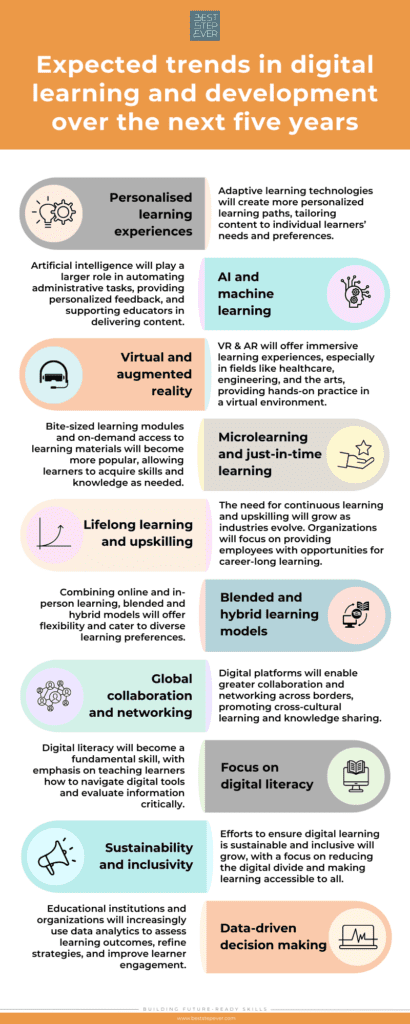Digital learning has moved into full swing!
The COVID-19 pandemic reshaped global education and training, thrusting digital learning into the spotlight and accelerating its adoption by several years. This forced educators, learners, and institutions to adapt rapidly to an online-first approach. Over the past few years, the global landscape of digital learning has continued to evolve, with significant advancements in technology and methodology shaping its current state.
A recent report on Skills Development in the Time of COVID-19, published by the International Labour Organization and the World Bank, highlights the lasting impact of the pandemic on vocational and technical education (TVET) sectors. These insights remain highly relevant across all educational fields, underscoring the pandemic's role in pushing forward the future of distance learning and prompting significant shifts in policy and practice.
By 2022, educational institutions worldwide had largely adapted to the challenges posed by the pandemic. Research spanning over 130 countries demonstrated how policies and practices evolved to accommodate digital learning. The global economy experienced a major setback, with the International Labour Organization estimating a loss of 11% of working hours, equivalent to 300 million full-time jobs, in 2020. While these figures have improved, the pandemic's influence on skills development and emerging trends continues to be profound.
How COVID-19 disrupted global digital learning.
The pandemic exposed and exacerbated several existing challenges within the education sector, leading to significant changes in how skills development was approached.
The abrupt shift to remote learning in 2020 laid bare the stark disparities in technological infrastructure across the globe. While high-income countries could quickly transition to digital platforms, many low-income regions faced significant hurdles, including unreliable electricity, limited internet access, and a lack of essential devices. The digital divide was particularly pronounced in rural areas and underprivileged communities, where increased data usage imposed additional financial burdens.
Many countries lacked robust and user-friendly distance learning platforms, particularly at the national level. Even those with existing platforms faced challenges in scaling up and adapting to new delivery methods. Resistance to rapid technological change among educators and learners highlighted the need for more seamless and intuitive solutions.
In the corporate sector, creator platforms emerged as powerful tools for facilitating quick content creation, publication, and interaction. These platforms have become invaluable across various educational environments, making the process of digital learning more accessible and engaging.
Digital literacy among educators was initially low, leaving many unprepared for the sudden transition to online teaching. The pandemic underscored the need for comprehensive support systems to help educators develop the skills required for remote teaching, learner engagement, and classroom management. Many educational environments struggled to provide the necessary guidance and resources, resulting in inconsistent responses ranging from complete suspension of activities to ad-hoc online solutions.
In 2020, over one-third of TVET institutions had not incorporated any form of distance learning into their curriculum. Only a small fraction had done so regularly. By 2022, this scenario had changed dramatically. Institutions across Africa and other regions that lagged behind made significant strides in adopting digital education, driven by necessity and innovation.
The pandemic highlighted the stark financial disparities between high-income and low-income countries. In wealthier nations, approximately 75% of respondents reported a shift to fully remote learning, whereas less than 20% of low-income countries achieved similar transitions. This disparity contributed to a widening digital divide, affecting learners' access to quality education.
As institutions scrambled to adapt, experimentation with diverse approaches became the norm. Even those with excellent resources had to pivot to new learning delivery methods. Many countries have since adopted blended learning models, combining in-person and online components to create more flexible and resilient educational systems.
TVET providers employed creative solutions to continue delivering practical skills training. These included massive open online courses (MOOCs), Moodle, video tutorials, live video conferences, simulators, and national television channels in countries like the Democratic Republic of Congo, Madagascar, and Pakistan. Alternative assessment methods, such as practical tasks uploaded to learning platforms, video submissions, portfolios, simulations, and online discussions, became standard practice.
In lower-income countries, offline distance learning tools like television and printed resources remained more prevalent, while higher-income nations leveraged video conferencing and virtual learning platforms.
The pandemic fostered the development of innovative partnerships within education and training sectors. Government agencies, educational bodies, industry organizations, technology providers, and private institutions collaborated to address the crisis. Key factors that emerged included learner-centric practices, adaptability, and a willingness to embrace flexible, hybrid, and blended learning approaches.
As global economies transitioned to remote work, ICT-related occupations faced significant shortages due to accelerated digitalization. This shift highlighted pre-existing gaps in areas such as online platforms, learning materials development, networking, and cybersecurity. Addressing these shortages became a priority for organizations seeking to thrive in the digital age.
What trends developed and what lessons were learned?
Accelerate remote learning
The pandemic compelled countries to fast-track remote learning strategies, emphasizing the need for investment in digital technologies and skills. While wealthier nations continue to benefit from blended learning approaches, many low-income regions still face significant challenges related to equipment, internet access, and digital skills.
In the workplace, learning strategies have evolved beyond quick fixes. McKinsey identified six best practices for virtual learning, which remain relevant today:
| 1. | Establishing a learning-response team |
| 2. | Protecting employees in in-person programs |
| 3. | Adapting delivery methods |
| 4. | Promoting digital learning |
| 5. | Exploring alternative digital strategies |
| 6. | Preparing for multiple outcomes |
A recent Deloitte study highlighted a paradigm shift in the learning landscape:
- Virtual learning is here to stay, with around 60% of learning expected to be online permanently. Some companies predict it could be as high as 90%.
- There's a shift from conventional learning modes (pre-recorded e-learning, classroom) to experiential learning (simulations, gamification, podcasts, MOOCs).
- L&D skills for the future include learner-centered design thinking, audience-focused content creation, personalizing and contextualizing learning, and enhancing knowledge-sharing and collaboration.
- Organizations are focusing on developing internal capacity, using resources more effectively amid budget cuts.
The message is clear: Digital learning is here to stay. If you don't have a digital learning strategy in place, it's time to give it serious attention as a strategic imperative.
Build socio-emotional skills
The pandemic underscored the importance of socio-emotional skills, which proved crucial during times of crisis. Research surveys identified teamwork, flexibility, openness to change, self-motivation to learn, mutual respect and honesty as valuable attributes. The need for emotional and mental health support for educators and learners remains critical. articles from UNESCO, UNICEF, and The Lancet emphasize the importance of ongoing support, empathy, and connection.
In the workplace, professionals with high emotional intelligence and low COVID-19 stress levels performed better and exhibited fewer counterproductive behaviours. Business leaders had to adapt quickly to changing circumstances, providing reassurance and guidance to their teams. Emotional intelligence became a vital asset for navigating disrupted work environments and addressing increased stress levels.
The Deloitte study highlighted top-rated human capabilities among corporate respondents: resilience, emotional intelligence, empathy, adaptive thinking, social intelligence, critical thinking, and creativity. These skills are crucial for maintaining the emotional and mental health of future workspaces.
These are skills that artificial intelligence can't replace. Our learning agenda must embrace ongoing personal development, emotional intelligence, and resilience, occurring wherever people connect, both formally and informally. Business, HR, and L&D leaders are called upon to drive the necessary learning transformation agenda.
The time to prepare is now
A global survey conducted in 2023 by CEDEFOP supports the findings of the ILO report. In the wake of the pandemic, three in four enterprises plan to:
- Increase investment in distance platforms and tools.
- Introduce or increase blended learning approaches.
- Build staff capacity to design and deliver online training.
The pandemic has served as a wake-up call, emphasizing the need to better prepare for future crises. Educational institutions and organizations must develop contingency plans, invest in distance learning infrastructure, and support educators and learners in navigating the digital landscape.
As we look to the future, several key trends are expected to shape digital learning over the next five years:

In conclusion, the digital learning landscape has undergone a significant transformation since the pandemic, and the pace of change shows no signs of slowing down. The key to success in this new era lies in embracing technology, fostering socio-emotional skills, and preparing for future challenges. By staying ahead of these trends, organizations can ensure they lead rather than lag in the digital learning revolution.


